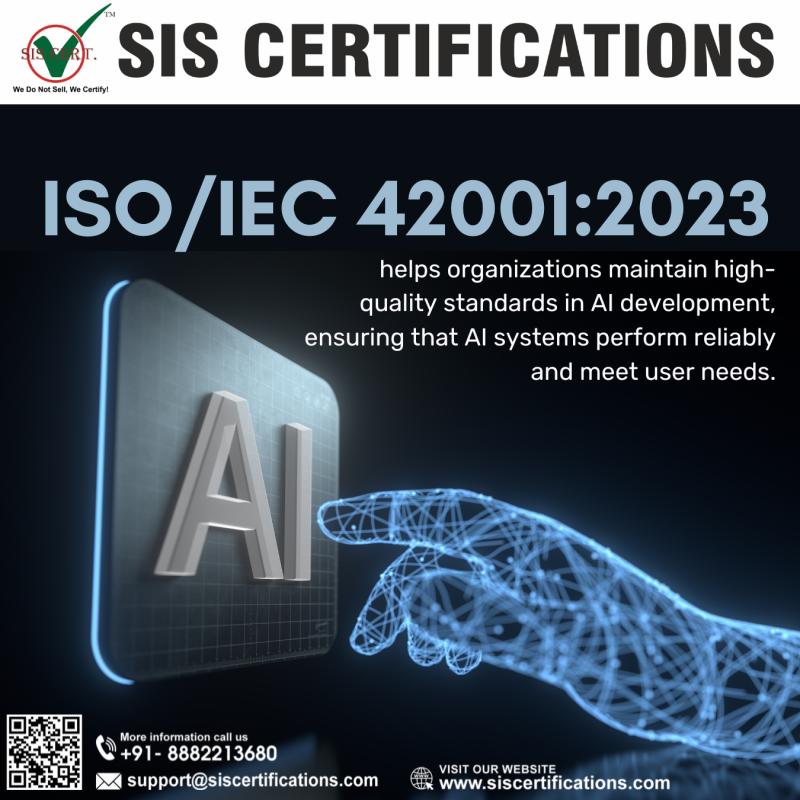How to Integrate ISO Standards into the AI Development Life Cycle

The integration of ISO standards
into the Artificial Intelligence (AI) development life cycle is essential for
ensuring quality, safety, and ethical considerations in AI systems. As AI
technologies evolve, the need for robust frameworks that govern their design
and deployment becomes increasingly critical. This article outlines a
structured approach to effectively integrate ISO standards into the AI
development life cycle, enhancing both the reliability and credibility of AI
solutions.
Understanding ISO Standards
Relevant to AI
ISO standards provide guidelines
that promote best practices in various fields, including technology and AI. The
ISO/IEC JTC 1/SC 42 committee focuses specifically on AI, creating standards
that address aspects such as data management, algorithms, and ethics.
Familiarity with these standards is the first step toward their integration.
- ISO/IEC 27001: This standard focuses on
information security management, critical for safeguarding sensitive data
used in AI systems.
- ISO/IEC 25012: Addresses data quality,
ensuring that data used for training AI models meets quality requirements.
- ISO 9001: The quality management standard
emphasizes continuous improvement, which is vital for AI development.
- ISO/IEC TR 24028: Provides guidelines on the
ethical use of AI, ensuring that AI systems operate within accepted moral
frameworks.
Steps for Integration
Integrating ISO standards into
the AI development life cycle involves several key steps, which can be broken
down into phases:
- Planning Phase
- Identify Relevant Standards: Start by
identifying the ISO
42001:2023 standards applicable to your AI project. This requires a
thorough understanding of both the project scope and the relevant
regulations.
- Establish Objectives: Set clear objectives
that align with the ISO standards. These objectives should focus on
quality, security, and ethical considerations.
- Resource Allocation: Determine the
resources needed for compliance, including personnel training, tools, and
technologies.
- Development Phase
- Data Management: Implement ISO/IEC 25012 to
ensure that data used in AI training is of high quality. This includes
defining data quality requirements such as accuracy, completeness, and
timeliness.
- Algorithm Design: Integrate ISO/IEC 27001
to incorporate security measures during algorithm development. Ensure
that data handling processes are secure and comply with privacy
regulations.
- Quality Assurance: Utilize ISO 9001
principles by establishing quality management processes. This involves
regular reviews and audits of the development process to identify areas
for improvement.
- Testing Phase
- Validation and Verification: Conduct
thorough testing to validate that the AI system meets the defined requirements
and ISO standards for AI. This includes unit testing, integration
testing, and system testing.
- Ethical Considerations: Implement the
guidelines from ISO/IEC TR 24028 to evaluate ethical implications during
testing. Ensure that the AI system does not perpetuate bias or violate
ethical norms.
- User Acceptance Testing (UAT): Involve
end-users in testing to gather feedback and identify potential issues.
This feedback loop is essential for quality improvement.
- Deployment Phase
- Compliance Checks: Before deployment,
conduct compliance checks to ensure all ISO standards have been met. This
involves a final review of documentation, processes, and system
performance.
- Training and Awareness: Train staff on the
ISO standards and their importance in the AI system’s operation.
Continuous education helps maintain compliance. Get ISO training
services online .
- Monitoring and Maintenance Phase
- Continuous Improvement: Implement a
feedback mechanism to monitor the AI system's performance
post-deployment. Use insights gained to make iterative improvements, in
line with ISO 9001 principles.
- Regular Audits: Schedule regular audits to
assess ongoing compliance with ISO standards. This will help identify any
lapses in adherence to quality, security, or ethical guidelines.
- Stakeholder Engagement: Maintain open
communication with stakeholders regarding any changes or improvements
made to the AI system. This fosters transparency and trust.
Challenges and Solutions
Integrating ISO standards into
the AI development life cycle may present challenges, including:
- Complexity of Standards: Understanding and
applying multiple ISO standards can be daunting. Solution: Invest
in training programs for team members to build expertise in relevant ISO
guidelines.
- Resource Constraints: Small teams may
struggle to allocate sufficient resources for compliance. Solution:
Leverage technology tools that automate compliance checks and facilitate
documentation management.
- Evolving Technology: The rapid pace of AI
innovation can outstrip current standards. Solution: Stay updated
on ISO revisions and actively participate in discussions about new
standards relevant to AI.
The Role of Stakeholders
Stakeholder involvement is
crucial for successfully integrating ISO standards. Key stakeholders include:
- Development Teams: Responsible for
implementing standards during the design and development phases.
- Quality Assurance Teams: Ensure that the AI
system meets quality benchmarks set by the ISO standards.
- Management: Provides necessary resources and
support for training and compliance efforts.
- End Users: Their feedback during testing
phases can highlight compliance gaps and areas for improvement.
Conclusion
Integrating ISO standards into
the AI development life cycle is essential for fostering high-quality, ethical,
and secure AI systems. By following a structured approach—from planning through
to monitoring—you can ensure that your AI solutions not only comply with
international standards but also meet the expectations of users and
stakeholders. As the field of AI continues to grow, adhering to ISO standards
will help build trust, enhance quality, and promote responsible innovation in
technology.
Post Your Ad Here
Comments